If the four-mile stretch of Powell Boulevard east of Interstate 205 is completely rebuilt in a few years, it could get some of Portland’s highest-quality bike lanes.
Some advocates say a meeting this Monday evening is the best chance yet to support Dutch-style raised bike lanes on outer Southeast Portland’s most important east-west arterial.
Today, east Powell is home to numerous businesses and other destinations between 99th Avenue and the Gresham border near 176th Avenue, but is missing even complete sidewalks for most of its length. East Portland advocates have long named biking and walking improvements on Powell as their No. 1 transportation priority, but it’s currently far from certain that protected bike lanes will be part of that plan.
The Outer Powell Conceptual Design Plan, approved in 2012 by the City of Portland and Oregon Department of Transportation, called for eight-foot-wide buffered bike lanes on most of the state-run road. But some say that recommendation might not hold up, let alone the curb-protected bike lane that people are dramatically more likely to perceive as a comfortable place to bike compared to a buffered lane.
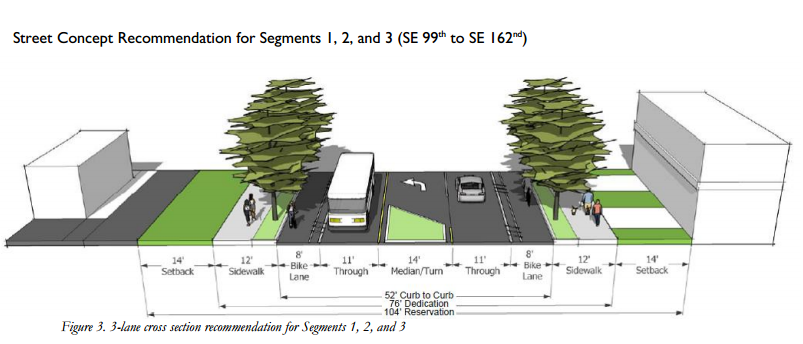
“In 2012, it was hard enough to get ODOT to accept and consider buffered lanes, let alone a more robust protected bike lane,” Portland-based biking advocate Nick Falbo wrote in an email Thursday on the BikeLoudPDX listserv. “If they are going to reconstruct the roadway (and it sounds like they are) then the added cost to make a raised bike lane should be negligible.”
“More than any previous meeting, this is the chance to get loud about the preferred Powell bicycle facility,” wrote Falbo, who in his professional life works as a bikeway planner for Alta Planning and Design.
The meeting is 6 to 8 p.m. on Monday, June 8, at Human Solutions, 12350 SE Powell Boulevard. The public comment period is scheduled for the end.
Last year, Falbo created a groundbreaking video of what he called a “protected intersection.” Something like it is now being built in four U.S. cities. The corner of 122nd and Powell was one of the intersections he used as models.
Advertisement
When we reported from East Portland for a week last summer, Powell’s importance as one of the area’s relatively few commercial corridors was impossible to ignore. Jim Chasse, a transportation advocate on the East Portland Action Plan bike committee who has lived just off this stretch of Powell for decades, told us at the time that protected bike lanes, also known as cycle tracks, would help turn the street into the area’s main street, with shops and other employers that can easily be walked or biked among instead of just driven to.
“Powell can stay relatively small, especially if we have high-capacity transit coming out on Division,” Chasse said. “There’s enough room in and around the whole facility to do a really good buildup. Cycle tracks in some areas and bike lanes in the constrained areas. And definitely sidewalks. … There’s already an established business district at 122nd, 112th, and going down to the 205 interchange.”
Chasse said in an email Friday that he, too, plans to attend Monday’s meeting. So did Emily Guise, an advocate with BikeLoud.
Elizabeth Quiroz, the Bicycle Transportation Alliance’s full-time organizer and advocate in East Portland, said Friday that the many relatively low-income neighborhoods and communities of color along the street “have been advocating for improvements in Outer Powell, and I think it’s time that we give them the best walking and biking facilities possible.”
In her email, Quiroz said there would be “some time at the end of the meeting for public comment 5 mins to be exact. This is an opportunity for people to come listen and talk about not only bike facilities but walking along the corridor.”
Protected bike lanes on Powell would come with some complications. TriMet’s frequent-service No. 9 bus runs along Powell. With the current buffered bike lane plan, it would be likely to pull across the bike lane at each stop. Floating bus stops would allow continuous raised bike lanes while improving average bus speeds, but might force people driving to sometimes wait behind a bus that has stopped.
Interested in this issue but unable to attend? You can also submit a comment online to ODOT or to state Rep. Shemia Fagan, who represents the area and has supported improvements for Powell.


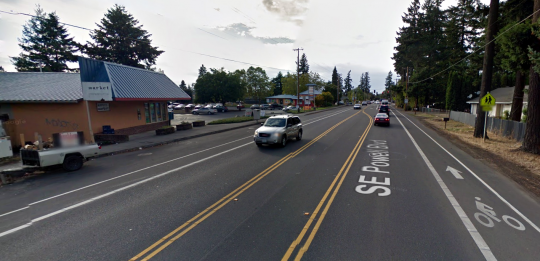
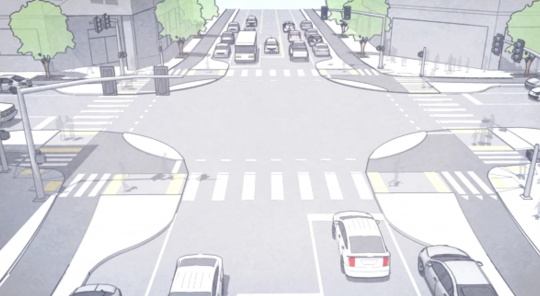
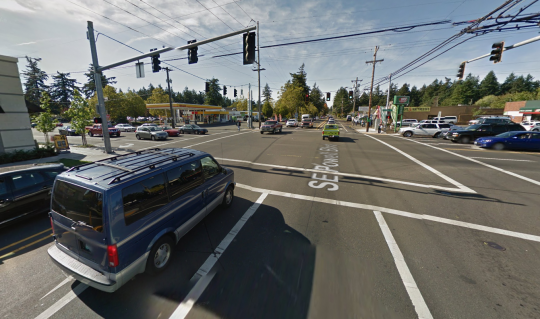
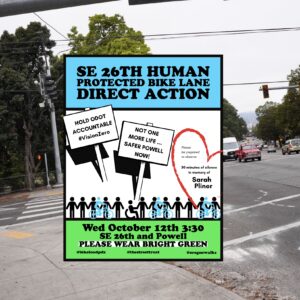
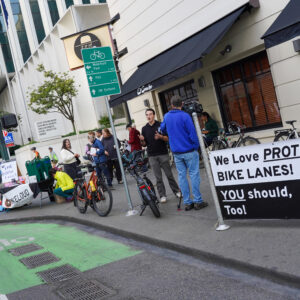
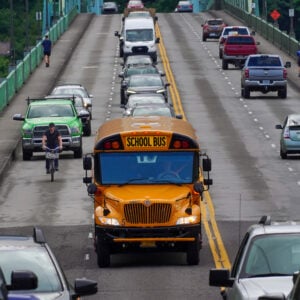
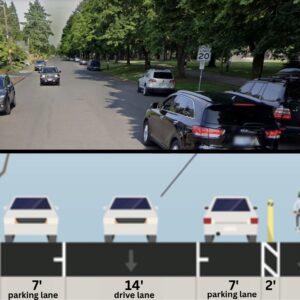
Thanks for reading.
BikePortland has served this community with independent community journalism since 2005. We rely on subscriptions from readers like you to survive. Your financial support is vital in keeping this valuable resource alive and well.
Please subscribe today to strengthen and expand our work.
I’ve wondered here aloud many times whether, when considering this, or really any future infrastructure changes, the folks at PBOT take into account the plausible decline in automobile dominance in the near future? Whether this as a variable is included in the conversations?
Even if many don’t think this is very likely—and if bikeportland commenters are a fair cross section that would probably be a fair fraction—I think it is important to at least parameterize this. The Paris talks may turn out to be disappointing, but that won’t be for lack of a growing sense of foreboding on the part of the world’s people who are paying attention.
If we take the climate challenge seriously, automobility is done for, should be phased out post haste, or even sooner. Not because I want to ‘take your car away’ but because the writing’s on the wall.
The folks at PBOT? You do mean ODOT on a state road, don’t you?
Yes, you’re right, in this case it would be ODOT. But my question applies to any roads, and we often talk about infrastructure over which PBOT has jurisdiction and is contemplating upgrades.
I don’t see a reduction in auto dominance. I see a tightening of fossil fuel supplies. I see a transition to hybrids, natural gas and all electric. I see a slow but steady transition to automated people delivery.
If a majority is 50%+1, non-dominance has a long way to go.
How much of those users are enthusiastic users? I think if we could convince the unenthusiastic users that multimodal (density, transit, ped, bike) infrastructure will be to their ultimate benefit, then we will see a major shift in the way money allocated. We need to get the grumbling middle to see the light about pouring funding into other modes.
“I don’t see a reduction in auto dominance.”
I know what you mean.
“If a majority is 50%+1, non-dominance has a long way to go.”
What I am talking about has nothing to do with a shift in preferences, and everything to do with looming constraints. Exogenous shocks to the system over which we as individuals, transportation consumers, or cities have, basically, zero control: oil price spikes, climate change induced insights about what we can and cannot afford to keep doing.
Unless you put together a big carbon or pollution tax you won’t get oil to stay much above $80 anytime soon. At that price enough fracked wells are profitable to stabilize prices, short term supply crunches are all that will send prices past that.
So the US is going to try to become Saudi Arabia by stifling renewables and putting a cartel on their fracked oil so everyone is thirsty and desperate and needs to grovel to us?
Fracking has about doubled US domestic oil production, but it likely won’t last for that long – a few decades at the most. Its also not going to keep prices low, as drilling new wells is exceedingly expensive compared to wells in Saudi Arabia, the Gulf, and places like Venezuela.
I hope so; part of the way a multimodal future will make sense is with competitive renewables or overly expensive oil. If oil stays cheap, it lets people ideologically oppose renewables by voting with their wallets. If the market makes that impossible for the majority of people, it’s for the best.
Who can we e-mail to make a comment to if we cannot be present? ODOT reps? City reps? County? State…?
Good question. It’s mostly ODOT, but state Rep. Shemia Fagan is probably a good contact too. I added links at the bottom of the post.
Thank you!
State legislators are to ODOT what City Council persons/commissioners are to PBOT. Contact your local legislator, tell them what you think. Democracy at work.
I just drove this section of Powell this afternoon. On three occasions, I saw motorists drive in the bike lane to get around vehicles stopping to make a left turn. I also saw yard sale A-frame signs erected in the bike lane. A barrier between the motor vehicle lane and the bike lane would at least help the former problem.
Maybe we need to get some people injured or killed there so that the City & ODOT will listen.
We should be disgusted and moved to action that this is a reality.
We have had plenty of deaths along outer Powell just in the past 12 months, usually motorists going too fast, hitting pedestrians j-walking along the street. Anyone walking along Powell can see such incidents as “inevitable.” And, yes, there are very few sidewalks, so pedestrians must use the (long-) existing bike lanes for walking.
The sidewalks are the big deal here. This stretch desperately needs them.
Yes, please!
More and more cities have started to embrace the idea of transit vehicles stopping in the lane, even when there is no legal way for cars to drive around. It reduces delay for buses by not forcing them to wait for a gap in traffic to pull back into the lane, and it helps meter and slow down traffic in a way that improves safety. Seattle has several such streets where they have deliberately chosen to give transit that level of priority even if it slows down traffic. Portland should take the same approach with streets like Powell.
I hope they don’t look to sw multnomah, moody, or capitol and terwilliger as good examples of cycle track. The only examples of protected bike infrastructure I’ve seen built around here have been undergrown sidewalks. The new road to nowhere on south waterfront is a pretty good layout, but far from auto traffic and wouldn’t work in a commercial area.
8ft with a mountable curb or buffer would work, but with 11ft lanes running 60mph (why else would you need 11ft?), it will be far more pleasant to ride on the sidewalk.
Oh man, and with the ongoing SE 136th improvements…. I’m stoked for the attention the deep SE is getting